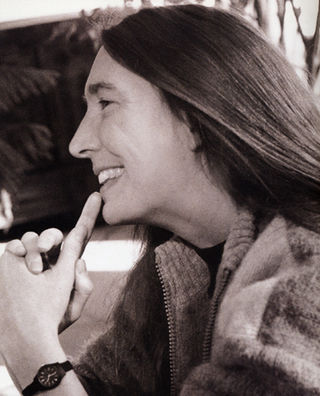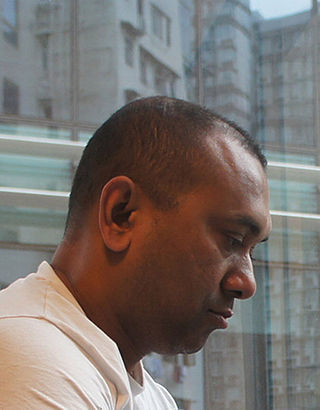
Jana Sterbak is a multidisciplinary artist of Czech origin.

Jenny Holzer is an American neo-conceptual artist, based in Hoosick, New York. The main focus of her work is the delivery of words and ideas in public spaces and includes large-scale installations, advertising billboards, projections on buildings and other structures, and illuminated electronic displays.
Sarah Sze is an American artist and professor of visual arts at Columbia University. She has exhibited internationally and her works are in the collections of several major museums. Sze's work explores the role of technology and information in contemporary life utilizing everyday materials. Drawing from Modernist traditions, Sze's work often represents objects caught in suspension.

Shirazeh Houshiary is an Iranian-born English sculptor, installation artist, and painter. She lives and works in London.
Bipasha Hayat is a leading Bangladeshi actress, model, painter and playback singer. She won Bangladesh National Film Award for Best Actress for her performance in the film Aguner Poroshmoni (1994). She earned Meril Prothom Alo Awards in 1998, 1999 and 2002.

Geeta Kapur is a noted Indian art critic, art historian and curator based in New Delhi. She was one of the pioneers of critical art writing in India, and who, as Indian Express noted, has "dominated the field of Indian contemporary art theory for three decades now". Her writings include artists' monographs, exhibition catalogues, books, and sets of widely anthologized essays on art, film, and cultural theory.

Rajeeb Samdani is a Bangladeshi industrialist and art collector. As of 2021, he is the managing director of Golden Harvest Group, a Bangladeshi conglomerate, and the founder and trustee of Samdani Art Foundation which produces the Dhaka Art Summit.

Shilpa Gupta is a contemporary Indian artist based in Mumbai, India. Gupta's artistic practise encompasses a wide range of mediums, including manipulated found objects, video art, interactive computer-based installations, and performance.

The Samdani Art Foundation is a private art foundation founded in 2011 in Dhaka, Bangladesh that aims to increase artistic engagement between the art and architecture of Bangladesh and the rest of the world. It is best known for producing the bi-annual Dhaka Art Summit, which is the highest daily visited contemporary art exhibition in the world, welcoming over 477,000 visitors in its fifth edition in February 2020. It completed its sixth edition in 2023. The foundation produces education programmes and exhibitions across the year in collaboration with Bangladeshi and international institutions and is one of the most active art institutions in South Asia.

Bangladeshi art is a form of visual arts that has been practiced throughout the land of what is now known as Bangladesh. Bangladeshi art has a perennial history which originated more than two thousand years ago and is practiced even to this date. Among the various forms of Bangladeshi art, photography, architecture, sculpture and painting are the most notable.

Simone Leigh is an American artist from Chicago who works in New York City in the United States. She works in various media including sculpture, installations, video, performance, and social practice. Leigh has described her work as auto-ethnographic, and her interests include African art and vernacular objects, performance, and feminism. Her work is concerned with the marginalization of women of color and reframes their experience as central to society. Leigh has often said that her work is focused on “Black female subjectivity,” with an interest in complex interplays between various strands of history. She was named one of the 100 most influential people in the world by Time magazine in 2023.
Yin Xiuzhen is a Chinese sculpture and installation artist. She incorporates used textiles and keepsakes from her childhood in Beijing to show the connection between memory and cultural identity. She has also employed pots and pans, wooden chests, suitcases and cement in her work. She studied oil painting in the Fine Arts Department of Capital Normal University, then called Beijing Normal Academy, in Beijing from 1985 to 1989. After graduation, Yin taught at the high school attached to the Central Academy of Fine Arts in Beijing, until her exhibition schedule became too demanding. Her work has been described by Phyllis Teo as “possessing human warmth, intimacy, and a sense of nostalgia which propels introspection of one's self—traditions, emotions, and beliefs. Thus, creating of a sense of community and belonging within the audience .”
June Yap is a Singaporean curator, art critic, and writer. She is currently the Director of Curatorial & Collections at the Singapore Art Museum.

Shirley Tse is an American contemporary artist born in Hong Kong. Tse's work is often installation based and incorporates sculpture, photography and video, and explores sculptural processes as models of multi-dimensional thinking and negotiation. She is faculty in the School of Art at California Institute of the Arts, and was the Co-Director of the Program in Art from 2011-2014. She is co-organizer of the ReMODEL Sculpture Education Now symposia series and has been visiting faculty at Yale School of Art, Northwestern University, California College of Arts and Crafts, and Claremont Graduate University.

Firoz Mahmud is a Bangladeshi visual artist based in Japan. He was the first Bangladeshi fellow artist in research at Rijksakademie Van Beeldende Kunsten in Amsterdam. Mahmud's work has been exhibited at the following biennales: Sharjah Biennale, the first Bangkok Art Biennale, at the Dhaka Art Summit, Setouchi Triennale (BDP), the first Aichi Triennial, the Congo Biennale, the first Lahore Biennale, the Cairo Biennale, the Echigo-Tsumari Triennial, and the Asian Biennale.
Alexie Glass-Kantor is an Australian curator. Since 2013, she has held the position of Executive Director of Artspace Visual Arts Centre in Sydney.

Nadia Kaabi-Linke is a Tunis-born, Berlin-based visual artist best known for her conceptual art and 2011 sculpture Flying Carpets. Her work has explored themes of geopolitics, immigration, and transnational identities. Raised between Tunis, Kyiv, Dubai and Paris, she studied at the Tunis Institute of Fine Arts and received a Ph.D. in philosophy of art from the Sorbonne. Kaabi-Linke won the 2011 Abraaj Group Art Prize, which commissioned Flying Carpets, a hanging cage-like sculpture that casts geometric shadows onto the floor akin to the carpets of Venetian street vendors. The piece was acquired by the New York Guggenheim in 2016 as part of their Guggenheim UBS MAP Global Art Initiative. Kaabi-Linke also won the Discoveries Prize for emerging art at the 2014 Art Basel Hong Kong. Her works have been collected by the Museum of Modern Art, Dallas Museum of Art, Burger Collection, and Samdani Art Foundation, and exhibited in multiple solo and group shows.
Duan Jianyu is a prominent contemporary visual artist from China and writer. The artist is primarily known for her surrealist-style of paintings that draw from a range of art histories, including European-American modernism, Chinese ink painting, and Chinese Socialist Realism.
Wah Nu is a contemporary artist from Myanmar.

Osman Yousefzada is a British interdisciplinary artist, writer and social activist. He launched his eponymous label Osman in 2008, and expanded his practice into a visual art space since 2013, with a 'zine' called The Collective - a cross disciplinary publication of themed conversations, between writers, artists, and curators, including, Milovan Farronato, Hans Ulrich Obrist, Nicola Lees, Celia Hempton, Anthea Hamilton, Prem Singh and others. Osman has shown internationally at various institutions, from the Whitechapel Gallery, V&A, Dhaka Art Summit, Lahore Biennale, Lahore Museum, Cincinnati Art Museum, Ringling Museum, Florida, Almaty Museum and solo at the Ikon Gallery in 2018.













